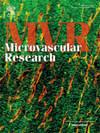蛛网膜下腔出血小鼠模型的局部肺血管改变
IF 2.7
4区 医学
Q2 PERIPHERAL VASCULAR DISEASE
引用次数: 0
摘要
蛛网膜下腔出血(SAH)导致神经源性肺水肿(NPE),这是一种由静水压力和血管渗透性增加引起的高死亡率的疾病。NPE的两种可能机制是静水压力增加和血管通透性增加,肺部毛细血管通透性增加可能导致NPE的加重。最近的研究强调了糖萼(排列在血管上的凝胶状层)在调节各种疾病的血管通透性方面的重要性。然而,其在SAH后NPE中的作用尚未被探讨。本研究通过建立小鼠SAH模型来探讨糖萼在NPE发生中的作用。方法采用颈动脉穿孔和大池输血相结合的方法建立小鼠SAH模型。显微ct、组织病理学检查及扫描电镜检查证实肺组织结构。结果微ct未见明显肺水肿,但苏木精染色及伊红染色肺组织病理改变。扫描电镜显示肺微血管壁内糖萼脱落。血浆中syndecan-1水平也有升高的趋势。结论在SAH后,ICA穿孔和大池输注联合可引起小鼠模拟NPE的肺部表现。结果还表明,糖萼丢失参与了SAH后NPE的发展。本文章由计算机程序翻译,如有差异,请以英文原文为准。

Localized pulmonary vascular changes in a mouse model of subarachnoid hemorrhage created by combining filament perforation and blood injection
Introduction
Subarachnoid hemorrhage (SAH) results in neurogenic pulmonary edema (NPE), a condition with a high mortality rate arising from increased hydrostatic pressure and vascular permeability. Two possible mechanisms of NPE are increased hydrostatic pressure and increased vascular permeability, and it is possible that increased permeability of capillaries in the lungs may contribute to the exacerbation of NPE. Recent research has highlighted the importance of the glycocalyx, a gel-like layer that lines blood vessels, in regulating vascular permeability in various diseases. However, its role in NPE after SAH has not been previously explored. This study investigated the involvement of the glycocalyx in the development of NPE by developing a mouse model of SAH.
Methods
The SAH model was developed by combining internal carotid artery (ICA) perforation and blood infusion into the cisterna magna of mice. The histological structure of the lungs was confirmed using micro-CT, histopathological examination, and scanning electron microscopy.
Results
Despite no obvious micro-CT findings indicating pulmonary edema, histopathological changes in hematoxylin and eosin-stained lung were detected. Scanning electron microscopy revealed glycocalyx exfoliation within the pulmonary microvascular wall. A trend toward higher plasma syndecan-1 levels was also observed.
Conclusion
The combination of ICA perforation and blood infusion into the cisterna magna can produce pulmonary findings in mice that mimic NPE after SAH. The results also suggest that glycocalyx loss is involved in the development of NPE after SAH.
求助全文
通过发布文献求助,成功后即可免费获取论文全文。
去求助
来源期刊

Microvascular research
医学-外周血管病
CiteScore
6.00
自引率
3.20%
发文量
158
审稿时长
43 days
期刊介绍:
Microvascular Research is dedicated to the dissemination of fundamental information related to the microvascular field. Full-length articles presenting the results of original research and brief communications are featured.
Research Areas include:
• Angiogenesis
• Biochemistry
• Bioengineering
• Biomathematics
• Biophysics
• Cancer
• Circulatory homeostasis
• Comparative physiology
• Drug delivery
• Neuropharmacology
• Microvascular pathology
• Rheology
• Tissue Engineering.
 求助内容:
求助内容: 应助结果提醒方式:
应助结果提醒方式:


